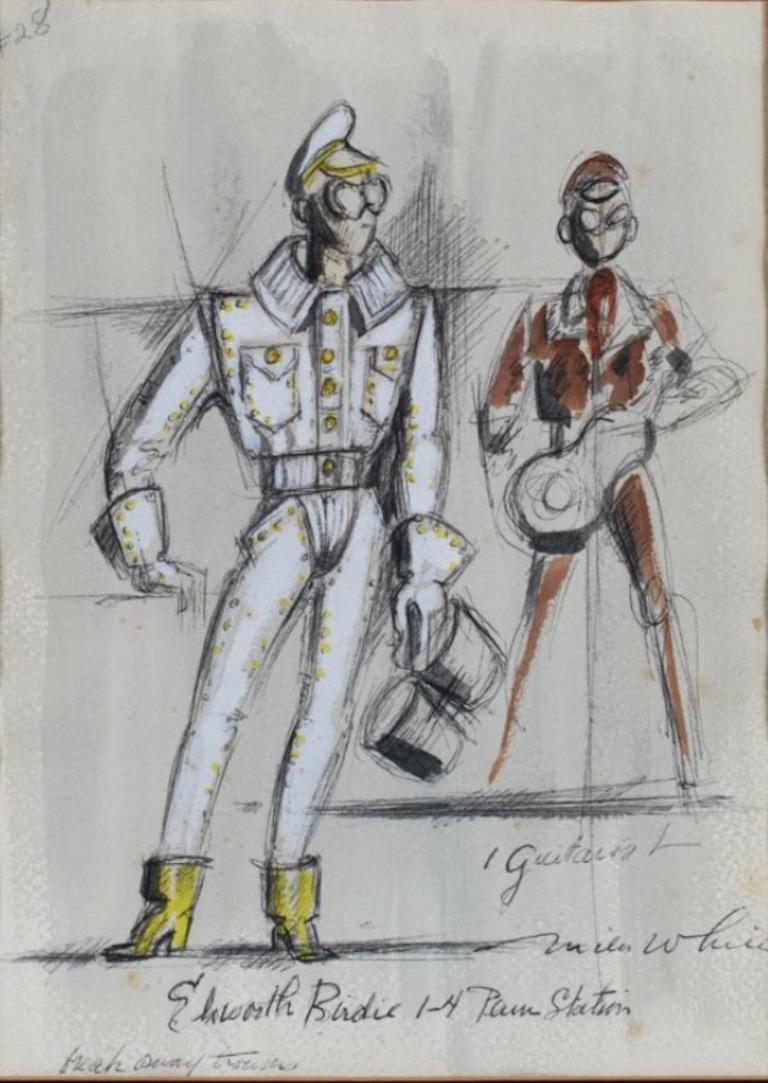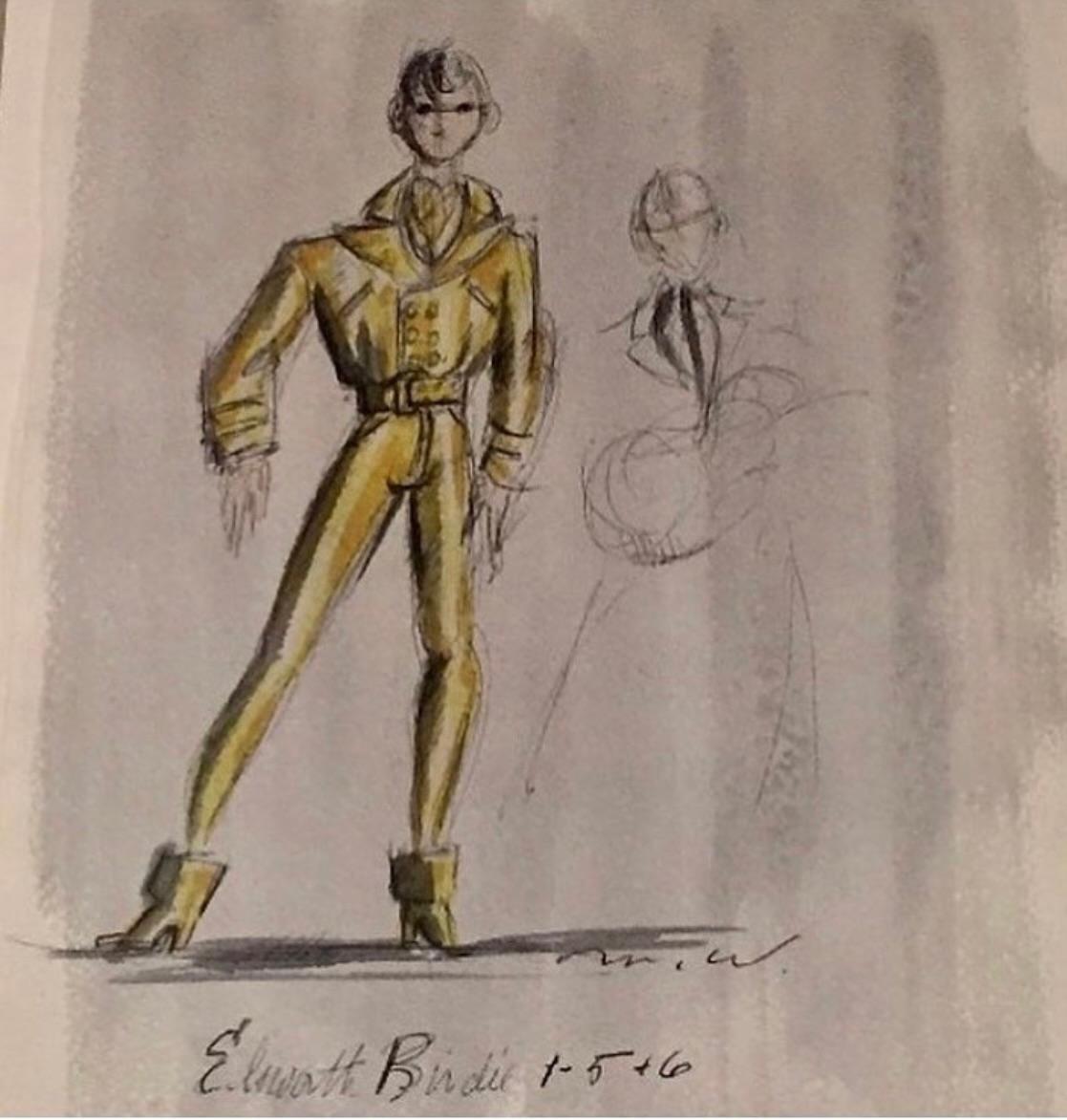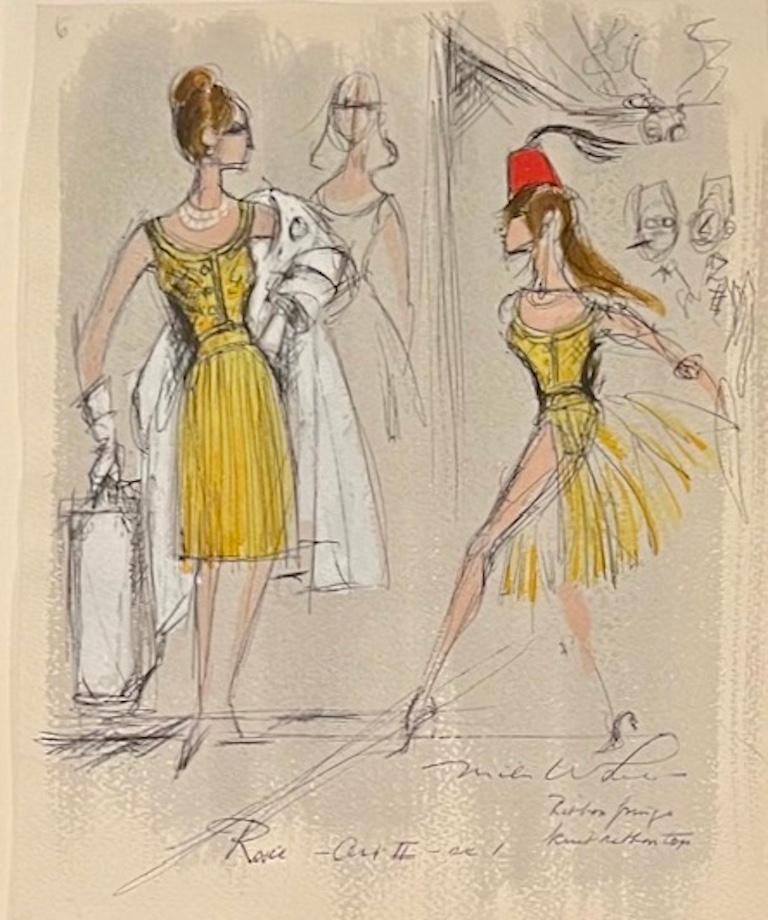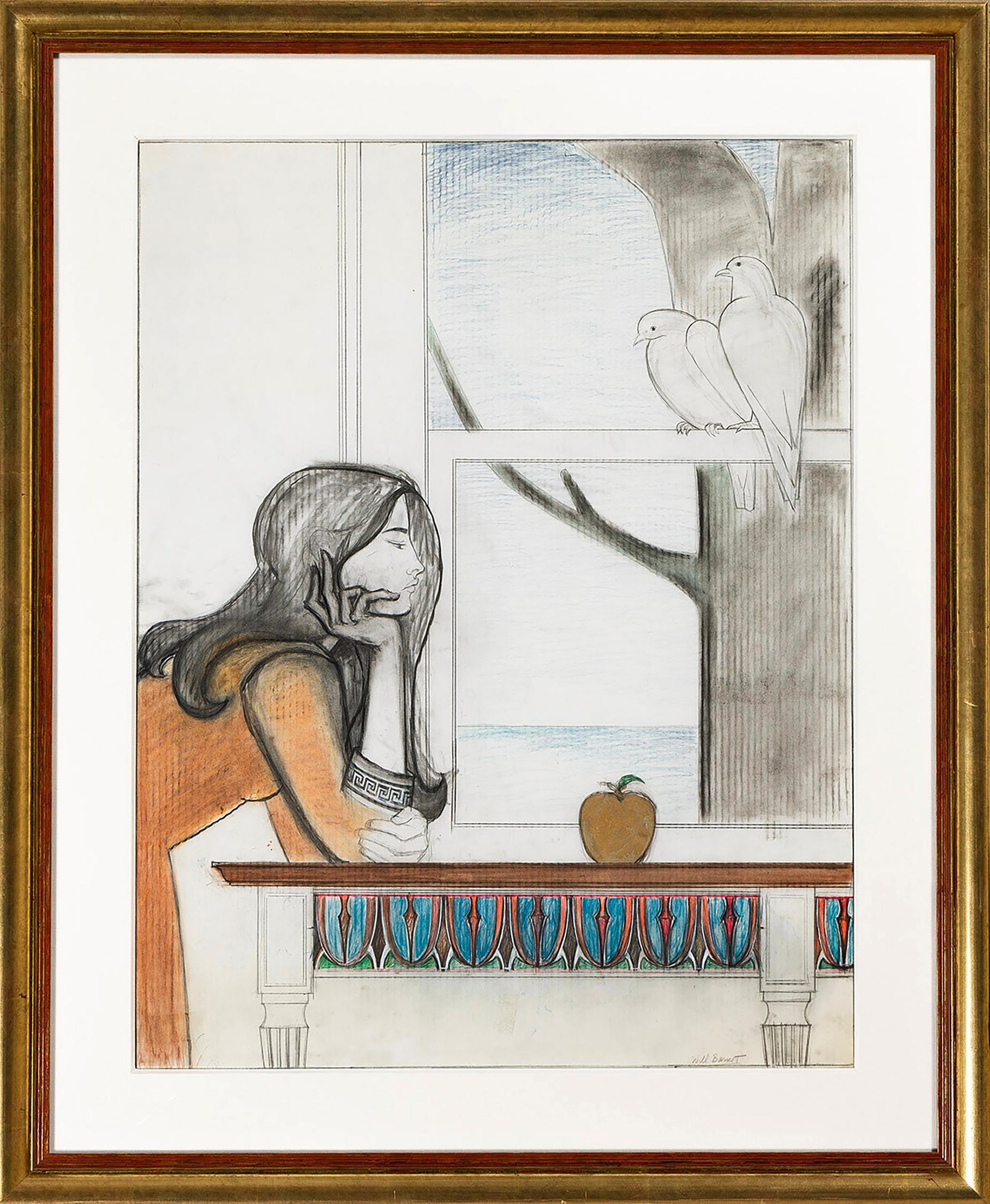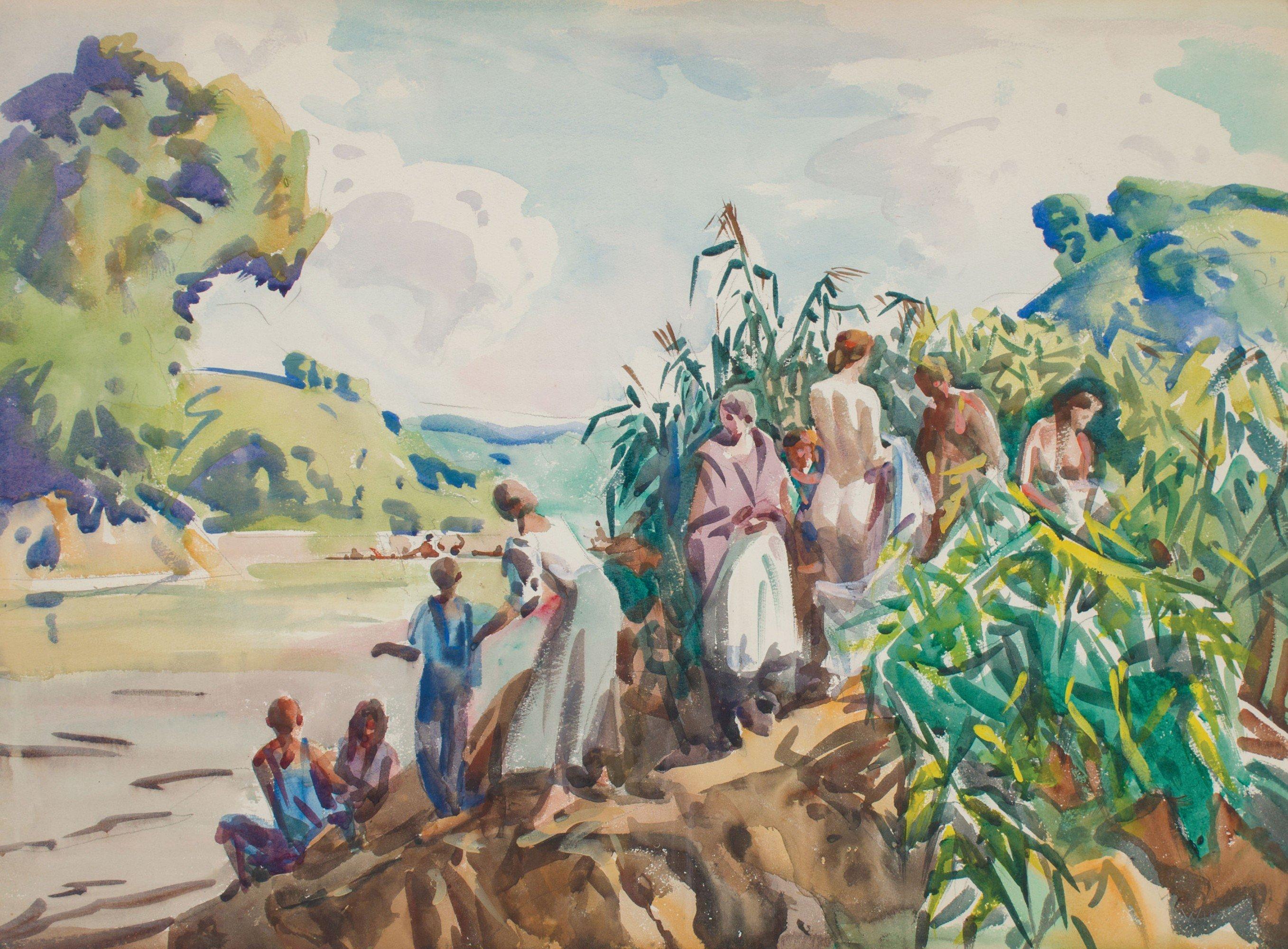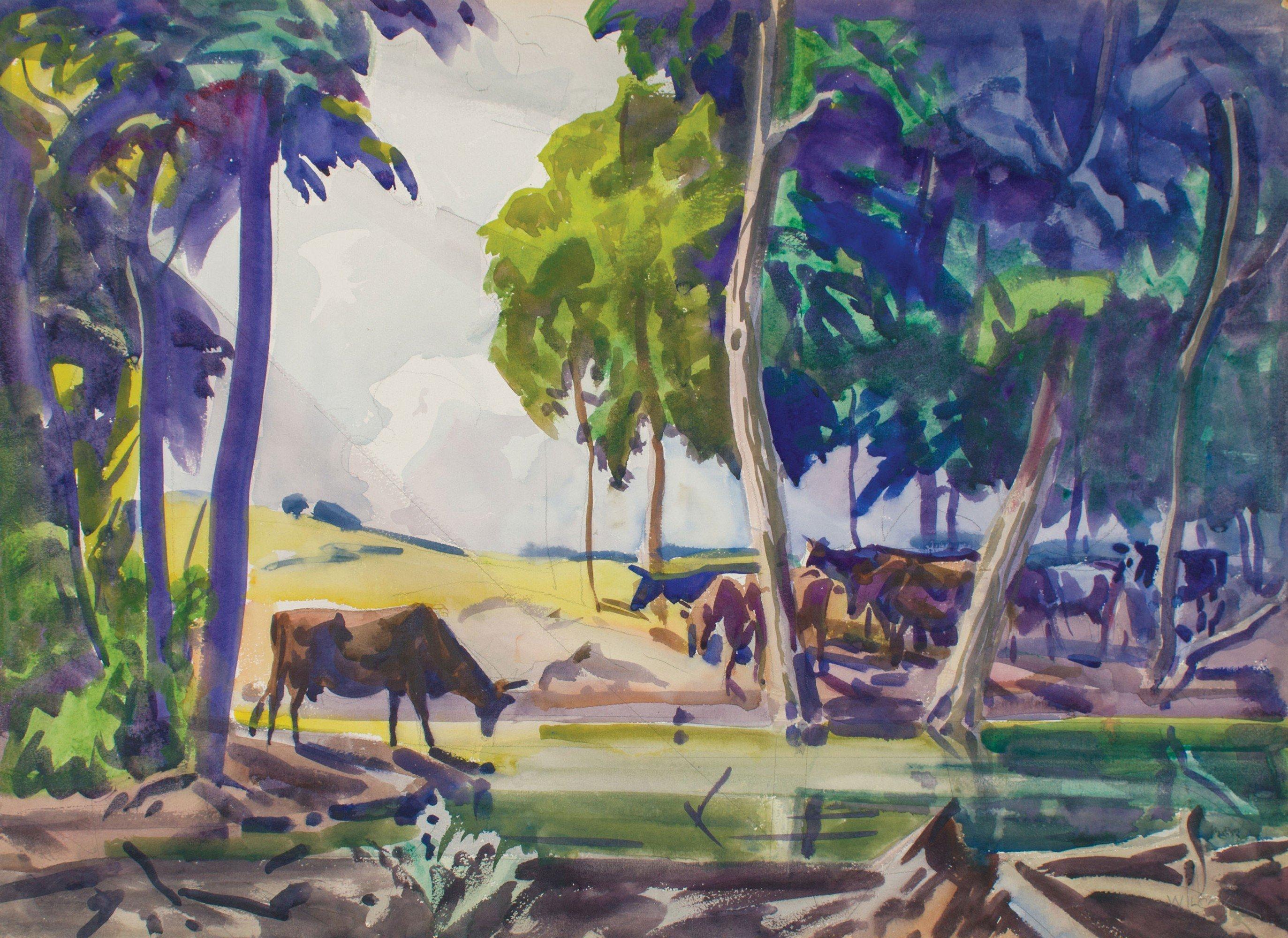Items Similar to Theatrical Costume - Drawing by Eugène Berman - 20th Century
Want more images or videos?
Request additional images or videos from the seller
1 of 2
Eugène BermanTheatrical Costume - Drawing by Eugène Berman - 20th Century20th Century
20th Century
About the Item
Theatrical Costume is an original drawing in watercolor and pencil on paper, glued on cardboard, realized by Russian scenographer Eugène Berman, hand-signed.
Image Dimension: 35 x 25 cm
Image Dimensions: 21.8 x 15 cm
Included a Passepartout.
In very good conditions.
Here the artwork represents various studies for theatrical costume of women.
Eugène Berman (Saint Petersburg, 1899 – Rome, 1972) was a Russian painter and theater and opera scenographer. His work earned the name of "Neo-Romantic" for the melancholy and the introspective features. Berman might have taken inspiration from Pablo Picasso's artworks, especially from the Blue Period paintings.
- Creator:Eugène Berman
- Creation Year:20th Century
- Dimensions:Height: 13.78 in (35 cm)Width: 9.85 in (25 cm)Depth: 0.04 in (1 mm)
- Medium:
- Movement & Style:
- Period:
- Framing:Framing Options Available
- Condition:Insurance may be requested by customers as additional service, contact us for more information.
- Gallery Location:Roma, IT
- Reference Number:
About the Seller
4.9
Platinum Seller
These expertly vetted sellers are 1stDibs' most experienced sellers and are rated highest by our customers.
1stDibs seller since 2017
6,749 sales on 1stDibs
Typical response time: 2 hours
- ShippingRetrieving quote...Ships From: Rome, Italy
- Return PolicyA return for this item may be initiated within 14 days of delivery.
More From This SellerView All
- The Dancer - Pencil/Watercolor by Maurice Van Moppes - Early 20th CenturyLocated in Roma, ITThe Dancer is an Original Pencil Drawing and Watercolour realized by Maurice Van Moppes. The artwork represents a young lady with her costume. Good condition, included a white card...Category
Early 20th Century Modern Figurative Drawings and Watercolors
MaterialsPencil, Watercolor
- Interior of The Church - Original Drawing by Rémy Hetreau - 1930sLocated in Roma, ITInterior of The Church is an original Artwork realized by Remy Hetreau (1913-2001). Realized with pencil, and watercolor on cardboard. in good condition.Category
1930s Modern Interior Drawings and Watercolors
MaterialsWatercolor, Pencil
- The Angels Captured City - Drawing by Mino Maccari - Mid-20th CenturyBy Mino MaccariLocated in Roma, ITThe Angels Captured City is an Original Drawing in watercolor and pencil on creamy-colored paper realized by Mino Maccari in the mid-20th century. Hand-signed by the artist on the l...Category
Mid-20th Century Modern Figurative Drawings and Watercolors
MaterialsWatercolor, Carbon Pencil
- The Conversation of Two Women - Drawing by Bernard Bécan - 1920sBy Bernard BécanLocated in Roma, ITThe Conversation of two women is a drawing in mixed media( pencil-watercolor-tempera) realized in the 1920s Century by Bernard Bécan (1890-1943). Hand-signed on the lower left. In ...Category
1920s Modern Figurative Drawings and Watercolors
MaterialsPencil, Tempera, Watercolor
- You Girl - Original Drawing by Alfred Grévin - Late 19 CenturyBy Alfred GrevinLocated in Roma, ITYou Girl is an original drawing in Mixed media realized by Alfred Grévin in the Late-19 Century In good conditions. Alfred Grévin (1827- 1892), was a 19th-century caricaturist, be...Category
Late 19th Century Modern Figurative Drawings and Watercolors
MaterialsWatercolor, Pencil
- The Musical Band - Drawing By Norbert Meyre - Mid 20th CenturyLocated in Roma, ITThe Musical Band is an original Drawing on paper realized by the French painter Norbert Meyre in the mid-20 century. Drawing in mixed media. The artwork is represented through deft...Category
Mid-20th Century Modern Figurative Drawings and Watercolors
MaterialsWatercolor, Pencil
You May Also Like
- BYE BYE BIRDIE Original 1960 Broadway Musical Costume Drawing Tony Award ElvisLocated in New York, NYBYE BYE BIRDIE Original 1960 Broadway Musical Costume Drawing Tony Award Elvis. Miles White (1915 – 2000) BYE BYE BIRDIE 11 x 8 inches Mixed Media on...Category
1960s American Modern Figurative Drawings and Watercolors
MaterialsWatercolor, Gouache, Pencil
- BYE BYE BIRDIE Original 1960 Broadway Musical Costume Drawing Tony Award ElvisLocated in New York, NYBYE BYE BIRDIE Original 1960 Broadway Musical Costume Drawing Tony Award Elvis Miles White (1915 – 2000) BYE BYE BIRDIE 11 x 8 inches Mixed Media on Paper Signed Lower Right Framed by Bark Affixed to the back are original gold lame fabric swatches. This drawing is available, along with two other original costume drawings from BIRDIE by Miles White, another of Conrad Birdie and one of Chita Rivera. Miles White, a leading Broadway and Hollywood costume designer for decades. created costumes for the original Broadway productions of OKLAHOMA CAROUSEL, BYE BYE BIRDIE and many others. In film he worked on "Around the World in 80 Days" and "The Greatest Show on Earth." He designed Ringling Bros and Barnum & Bailey Circus, and the Ice Capades for many years. Miles was a close friend for the last 20 years of his life. We live with one of his two Tony Awards and a dozen drawings. BYE BYE BIRDIE is a stage musical with music by Charles Strouse and lyrics by Lee Adams, based upon a book by Michael Stewart...Category
1960s American Modern Figurative Drawings and Watercolors
MaterialsWatercolor, Gouache, Pencil
- Chita Rivera BYE BYE BIRDIE Original 1960 Broadway Costume Drawing Tony AwardsLocated in New York, NYChita Rivera BYE BYE BIRDIE Original 1960 Broadway Costume Drawing Tony Awards Miles White (1915 – 2000) ChITA RIVERA in BYE BYE BIRDIE 11 x 8 inches M...Category
1960s American Modern Figurative Drawings and Watercolors
MaterialsWatercolor, Gouache, Pencil
- Final Study for Atalanta, Girl with AppleBy Will BarnetLocated in Greenwich, CTWill Barnet is one of America's best loved and known artists of the Post War era. He is highly distinctive for his figurative and narrative work and in some ways he is the Edgar All...Category
1970s American Modern Figurative Drawings and Watercolors
MaterialsWatercolor, Graphite, Color Pencil, Vellum
- Women's Corner, Along the Cuyahoga River, Early 20th Century Cleveland SchoolBy Frank WilcoxLocated in Beachwood, OHFrank Nelson Wilcox (American, 1887-1964) Women's Corner, Along the Cuyahoga River, c. 1916 Watercolor and graphite on paper 21 x 29 inches Frank Nelson Wilcox (October 3, 1887 – April 17, 1964) was a modernist American artist and a master of watercolor. Wilcox is described as the "Dean of Cleveland School painters," though some sources give this appellation to Henry Keller or Frederick Gottwald. Wilcox was born on October 3, 1887 to Frank Nelson Wilcox, Sr. and Jessie Fremont Snow Wilcox at 61 Linwood Street in Cleveland, Ohio. His father, a prominent lawyer, died at home in 1904 shortly before Wilcox' 17th birthday. His brother, lawyer and publisher Owen N. Wilcox, was president of the Gates Legal Publishing Company or The Gates Press. His sister Ruth Wilcox was a respected librarian. In 1906 Wilcox enrolled from the Cleveland School of Art under the tutelage of Henry Keller, Louis Rorimer, and Frederick Gottwald. He also attended Keller's Berlin Heights summer school from 1909. After graduating in 1910, Wilcox traveled and studied in Europe, sometimes dropping by Académie Colarossi in the evening to sketch the model or the other students at their easels, where he was influenced by French impressionism. Wilcox was influenced by Keller's innovative watercolor techniques, and from 1910 to 1916 they experimented together with impressionism and post-impressionism. Wilcox soon developed his own signature style in the American Scene or Regionalist tradition of the early 20th century. He joined the Cleveland School of Art faculty in 1913. Among his students were Lawrence Edwin Blazey, Carl Gaertner, Paul Travis, and Charles E. Burchfield. Around this time Wilcox became associated with Cowan Pottery. In 1916 Wilcox married fellow artist Florence Bard, and they spent most of their honeymoon painting in Berlin Heights with Keller. They had one daughter, Mary. In 1918 he joined the Cleveland Society of Artists, a conservative counter to the Bohemian Kokoon Arts Club, and would later serve as its president. He also began teaching night school at the John Huntington Polytechnic Institute at this time, and taught briefly at Baldwin-Wallace College. Wilcox wrote and illustrated Ohio Indian Trails in 1933, which was favorably reviewed by the New York Times in 1934. This book was edited and reprinted in 1970 by William A. McGill. McGill also edited and reprinted Wilcox' Canals of the Old Northwest in 1969. Wilcox also wrote, illustrated, and published Weather Wisdom in 1949, a limited edition (50 copies) of twenty-four serigraphs (silk screen prints) accompanied by commentary "based upon familiar weather observations commonly made by people living in the country." Wilcox displayed over 250 works at Cleveland's annual May Show. He received numerous awards, including the Penton Medal for as The Omnibus, Paris (1920), Fish Tug on Lake Erie (1921), Blacksmith Shop (1922), and The Gravel Pit (1922). Other paintings include The Trailing Fog (1929), Under the Big Top (1930), and Ohio Landscape...Category
1910s American Modern Figurative Drawings and Watercolors
MaterialsGraphite, Watercolor
- Cows by Woodland Pond, Toledo, Ohio, Early 20th Century Cleveland SchoolBy Frank WilcoxLocated in Beachwood, OHFrank Nelson Wilcox (American, 1887-1964) Cows by Woodland Pond, Toledo, Ohio, c. 1920 Watercolor and graphite on board Signed lower right 22 x 30 inches Frank Nelson Wilcox (October 3, 1887 – April 17, 1964) was a modernist American artist and a master of watercolor. Wilcox is described as the "Dean of Cleveland School painters," though some sources give this appellation to Henry Keller or Frederick Gottwald. Wilcox was born on October 3, 1887 to Frank Nelson Wilcox, Sr. and Jessie Fremont Snow Wilcox at 61 Linwood Street in Cleveland, Ohio. His father, a prominent lawyer, died at home in 1904 shortly before Wilcox' 17th birthday. His brother, lawyer and publisher Owen N. Wilcox, was president of the Gates Legal Publishing Company or The Gates Press. His sister Ruth Wilcox was a respected librarian. In 1906 Wilcox enrolled from the Cleveland School of Art under the tutelage of Henry Keller, Louis Rorimer, and Frederick Gottwald. He also attended Keller's Berlin Heights summer school from 1909. After graduating in 1910, Wilcox traveled and studied in Europe, sometimes dropping by Académie Colarossi in the evening to sketch the model or the other students at their easels, where he was influenced by French impressionism. Wilcox was influenced by Keller's innovative watercolor techniques, and from 1910 to 1916 they experimented together with impressionism and post-impressionism. Wilcox soon developed his own signature style in the American Scene or Regionalist tradition of the early 20th century. He joined the Cleveland School of Art faculty in 1913. Among his students were Lawrence Edwin Blazey, Carl Gaertner, Paul Travis, and Charles E. Burchfield. Around this time Wilcox became associated with Cowan Pottery. In 1916 Wilcox married fellow artist Florence Bard, and they spent most of their honeymoon painting in Berlin Heights with Keller. They had one daughter, Mary. In 1918 he joined the Cleveland Society of Artists, a conservative counter to the Bohemian Kokoon Arts Club, and would later serve as its president. He also began teaching night school at the John Huntington Polytechnic Institute at this time, and taught briefly at Baldwin-Wallace College. Wilcox wrote and illustrated Ohio Indian Trails in 1933, which was favorably reviewed by the New York Times in 1934. This book was edited and reprinted in 1970 by William A. McGill. McGill also edited and reprinted Wilcox' Canals of the Old Northwest in 1969. Wilcox also wrote, illustrated, and published Weather Wisdom in 1949, a limited edition (50 copies) of twenty-four serigraphs (silk screen prints) accompanied by commentary "based upon familiar weather observations commonly made by people living in the country." Wilcox displayed over 250 works at Cleveland's annual May Show. He received numerous awards, including the Penton Medal for as The Omnibus, Paris (1920), Fish Tug on Lake Erie (1921), Blacksmith Shop (1922), and The Gravel Pit (1922). Other paintings include The Trailing Fog (1929), Under the Big Top (1930), and Ohio Landscape...Category
1920s American Modern Figurative Drawings and Watercolors
MaterialsWatercolor, Graphite
